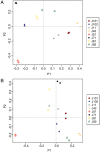Impact of experimental hookworm infection on the human gut microbiota
- PMID: 24795483
- PMCID: PMC4195438
- DOI: 10.1093/infdis/jiu256
Impact of experimental hookworm infection on the human gut microbiota
Abstract
The interactions between gastrointestinal parasitic helminths and commensal bacteria are likely to play a pivotal role in the establishment of host-parasite cross-talk, ultimately shaping the development of the intestinal immune system. However, little information is available on the impact of infections by gastrointestinal helminths on the bacterial communities inhabiting the human gut. We used 16S rRNA gene amplification and pyrosequencing to characterize, for the first time to our knowledge, the differences in composition and relative abundance of fecal microbial communities in human subjects prior to and following experimental infection with the blood-feeding intestinal hookworm, Necator americanus. Our data show that, although hookworm infection leads to a minor increase in microbial species richness, no detectable effect is observed on community structure, diversity or relative abundance of individual bacterial species.
Trial registration: ClinicalTrials.gov NCT00671138.
Keywords: 16S rRNA gene; chronic inflammatory disorders; experimental infection; hookworms; microbial richness; parasitic helminths; pyrosequencing.
© The Author 2014. Published by Oxford University Press on behalf of the Infectious Diseases Society of America.
Figures


References
-
- Yazdanbakhsh M, Kremsner PG, van Ree R. Allergy, parasites, and the hygiene hypothesis. Science. 2002;296:490–4. - PubMed
-
- Summers RW, Elliott DE, Urban JF, Jr, Thompson RA, Weinstock JV. Trichuris suis therapy for active ulcerative colitis: a randomized controlled trial. Gastroenterology. 2005;128:825–32. - PubMed
Publication types
MeSH terms
Associated data
Grants and funding
LinkOut - more resources
Full Text Sources
Other Literature Sources
Medical

